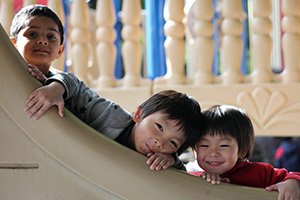Thank you to our Room 2 Parent Volunteer who came in today and introduced Wobble Boards to our Kindergarten Class, an Australian instrument following our theme of the month.


Learn And Play® Montessori School
Toddler, Preschool, Prek, Kindergarten and After School Programs
Enroll Now New Hercules Campus New San Carlos Campus



Happy Tuesday!
It was delightful to see parents observing their children on Parent Observation Days. This morning our Parent Observation Days Part II ended successfully. The patience and understanding demonstrated by the parents is immeasurable. For our younger children, parents did not mind standing outside as long as they could see through the window how their children are interacting with their teachers and friends. Our older children are proud and excited to see their parents observing and taking notes of their classroom environment. We are grateful to receive some parent feedback that we can apply for the school and the children. Your comments are our strength and inspiration. We appreciate the feedback and for investing the time to take an active part in your child’s education.
The next step after Parent Observation is the Parent-Teacher Conferences. On your scheduled conference, please be on time as there would only be a 15-minute time allotted for each family. Parent-Teacher Conferences will be held in the back office, during which time the parent observation notes and the progress reports will be discussed. Progress reports will only be given during scheduled Parent-Teacher Conferences. Please check the sign-up sheet in your child’s classroom for the time and date that you signed up for.
The April schedule is as follows:
Thursday, April 7 and Friday, April 8: Classroom 2
Monday, April 11 and Tuesday, April 12: Classroom 3
Wednesday, April 13 and Thursday, April 14: Classroom 4
Friday, April 15 and Monday, April 18: Classroom 5
Parent-Teacher Conferences for classrooms 6 through 10 are scheduled in May. Sign-up sheets are available in your child’s classroom.
Please speak with me or the front desk for your questions and concerns. Thank you for being a LAPMS family!

april newsletter niles 2016 edited2
April Event Guidelines
April 1, 4 and 5: Parent Observation Days: We encourage parents to sign up early to reserve your spot. Sign-up sheet is available in your child’s classroom. There would be four adults only for every 30 minute session. Observation notes will be available for note-taking. Thank you for the parents who came to observe the classroom.
April 7 and 8: Parent-Teacher Conferences for Room 2 classroom. Parents will meet with their child’s teacher and discuss the progress report of the child. There are 15 minutes allotted for each family. Parent conferences will be held in the back office. Sign-up sheet is available in your child’s classroom.
April 11 and 12: Parent-Teacher Conferences for Room 3 classroom.
April 13 and 14: Parent Teacher Conferences for Room 4 classroom.
April 15 and 18: Parent Teacher Conferences for Room 5 classroom.
April 22: Earth Day: The children will have fun and exciting Earth Day activities. Earth Day activities include projects reinforcing the concept of the 3 R’s–Reduce, Reuse and Recycle. There will be gardening activities, poster-making, and arts and crafts using recycled materials. Older children will view educational videos about the history of the earth and environmental concerns. Parents are welcome to schedule for a class presentation related to Earth Day. Please speak with your child’s teacher for volunteering in their classroom activities.
April 29: International Day Celebration at 10:30 A.M. in your child’s classroom: The children prepared performances showcasing cultures and traditions around the world. Performances will include songs, poems or chants, short skits, or folk dances from all over the world. We welcome you to share a dish for this celebration. Food items may be store-bought or homemade with ingredient list attached. Food containing eggs and nuts are not allowed. Ingredient cards are available at the front desk.

Congratulations to our LAPMS young scientists and their mentors for this year’s 2nd Annual Science Fair!
Thank you to our LAPMS parents and children for a successful Science Fair yesterday. Doing a science fair project is a wonderful learning opportunity that develops learning skills a child has been taught in our LAPMS curriculum. Our science curriculum integrates all subject areas that involve reading and writing, grammar, math, art and drawing, logical thinking, and the scientific method. We strongly support the preschool science standards as they are complemented by science fair projects including pre- and post-lab activities.
The science participants were excited explaining what they have discovered from their science experiments and describing their work in front of their classmates.
We applaud all science parent mentors and especially our young scientists at LAPMS for an achievement we all are very proud of!

Our Parent Observation Days will start tomorrow, Friday, April 1st until Tuesday, April 5th. Observation lasts for half an hour or less with a maximum of four slots or four adults. Sign-up sheet is available in your child’s classroom. Please be punctual on your scheduled observation time. We ask that you observe quietly, outside of the activity area and write your observations that will be discussed in the Parent-Teacher Conferences.
Parent-Teacher Conferences will follow after the Parent Observation Days. Classrooms 6 -10 Parent-Teacher Conferences are scheduled in May. The child’s progress report will be discussed and provided in the conference. The schedule and sign-up sheet are also available in your child’s classroom.
April 7 and 8——-Room 2
April 11 and 12—-Room 3
April 13 and 14—-Room 4
April 15 and 18—-Room 5
Please speak with me or the front desk for your questions and concerns. Have a wonderful day!

“April Showers bring May Flowers!”
As we begin the month of April, we hope we will all be able to enjoy warmer weather and many beautiful spring days.
We begin our month by posing for spring pictures. All of our children will be taking pictures, including our Kindergartners, who will be taking their graduation pictures.
In the month of April we are excited to learn about Europe, Pinnacles, Invertebrates and Botany!
We end this month by giving our parents an opportunity to come and observe their child in their classroom. We also look forward to our International Potluck. We are excited for the month of April!

We would like to thank all our parents that volunteered and donated in making our annual Easter egg hunt a success for all our Friends. As the classes begun this morning, all our children anticipated their turn to start their hunt. We heard “this is amazing” and our friends faces had big bright smiles as they scattered all around in the playground in hunt of Easter goodies. At the end, our friends were very much happy and eggs were shared all amongst each other. We appreciate all your generosity in making this event a memorable one for all our Niles Friends.

Happy Monday!
This is a gentle reminder that our Easter Egg Hunting Day is this Thursday, March 24th from 9:00 A.M. to 12:00 P.M. in the school grass field area or in the courtyard if weather permits. Some children made their own buckets from recyclable materials and other children decorated brown paper bags for egg hunting. Please let the front desk or your child’s teacher know if you do not wish your child to participate in this activity.
Parents are welcome to join with their children in egg hunting. Have fun and enjoy the moments together!
Please let us know your questions or concerns. Thank you for your generosity!

This is a friendly reminder of our upcoming Easter Activities.
Easter Egg Dyeing Activity
The children will be dyeing the eggs prior to the Easter Egg Hunt Activity.
Classroom 1, Classroom 2 and Classroom 3 will be dyeing their eggs on Thursday, March 24th 2016.
Classroom 4, Classroom 5 and Classroom 6 will be dyeing their eggs on Friday, March 25th 2016.
Easter Egg Hunt Activity – Friday, March 25th,2016
Our Easter Egg hunt will begin at 9:00. Each class will have 15 minutes to look for hidden eggs.
The schedule is as follows:
Classroom 1: 9:00 – 9:15 Classroom 2: 9:15 – 9:30
Classroom 3: 9:30 – 9:45 Classroom 4: 9:45 – 10:00
Classroom 5: 10:00 – 10:15 Classroom 6: 10:15- 10:30

*Terms and conditions apply.
Please select one of the links below to visit our social media accounts!
Please select one of the links below to go to a page where you can schedule a tour!